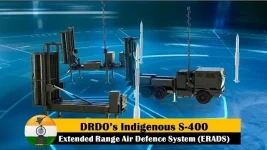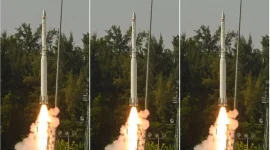- Views: 3K
- Replies: 14

India's Ballistic Missile Defence (BMD) program has achieved a significant milestone with the successful testing of the AD-1 interceptor missile under Phase II, marking a critical advancement in the nation's defence capabilities.
This development not only strengthens India's ability to neutralize long-range ballistic missiles but also introduces a nascent capability against emerging hypersonic threats.
While Phase III will see the development of dedicated anti-hypersonic interceptors, the AD-1's current performance offers a preliminary defence against these advanced weapons, highlighting India's strategic approach to future warfare.
The AD-1, a long-range interceptor developed by DRDO, is designed to engage and neutralize ballistic missiles with a range of up to 5,000 km. The interceptor is equipped with a dual-stage solid rocket motor for extended range, an active radar seeker for precise target acquisition, and is also engineered to counter maneuvering glide vehicles.
According to public statements by DRDO officials, these features enable it to engage targets outside the Earth's atmosphere (exo-atmospheric) as well as within it (endo-atmospheric). This capability places the AD-1 as part of the crucial phase II of India's two-tiered BMD system.
Notably, while its primary role is to intercept ballistic missiles, the AD-1 has demonstrated a secondary capability against Hypersonic Glide Vehicles (HGVs). However, the DRDO has clarified that this capability is limited to addressing modest hypersonic threats, specifically during the terminal phase of flight. This is the stage when the speed and maneuverability of the HGV are somewhat diminished, presenting a brief window for interception.
HGVs represent a new generation of offensive weaponry, characterized by their ability to travel at speeds exceeding Mach 5 (five times the speed of sound), execute unpredictable maneuvers, and maintain atmospheric flight for prolonged periods. These characteristics, particularly their ability to alter trajectory at hypersonic speeds, pose significant challenges to traditional missile defence systems.
The development of HGVs by China has spurred a global arms race in hypersonic technology, prompting India to develop counter measures.
Phase III of India's ambitious BMD program is set to address the limitations of Phase II by focusing on the development of two new interceptor missiles specifically tailored for hypersonic threats.
While details about these new interceptors remain limited, analysts speculate that they will likely leverage advanced technologies such as hit-to-kill mechanisms, improved guidance systems and possibly directed energy weapons to effectively counter the speed and agility of HGVs.
The inclusion of even a limited anti-hypersonic capability in the AD-1 significantly bolsters India's strategic deterrence posture. It serves as a clear signal to potential adversaries that India is actively preparing to counter the next generation of missile threats.
As the global landscape continues to evolve, India's investment in advanced missile defence systems like the AD-1 and the upcoming Phase III interceptors will be crucial for national security.


